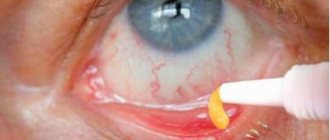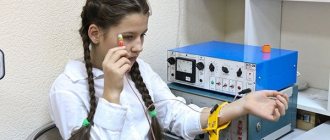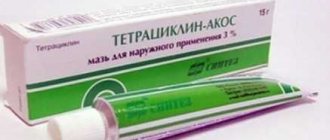When to use and how it works
According to the instructions, Erythromycin ophthalmic ointment is used as a mild antibiotic for the treatment of conjunctivitis in children, starting from infancy.
The composition of the drug is safe and does not have a toxic effect on the body.
When treating children, you must first consult a doctor , and only then use medications.
It is important to make a correct diagnosis: the symptoms of conjunctivitis in a child can be confused with the symptoms of another ophthalmological disease, inflammation.
The active components of the drug quickly penetrate the tear fluid and corneal tissue. Their penetration into the circulatory organs is excluded.
This feature explains the safety of the drug and the possibility of using it in the treatment of very young children.
Precautionary measures
Pregnancy and breastfeeding are a contraindication to the use of Erythromycin ophthalmic ointment, therefore, when carrying a child, using the medicine yourself, like other potent drugs, is strictly not recommended. In rare cases, doctors still prescribe it, for example, if weaker analogues are ineffective or if the possible risks are inferior to the expected effects.
When treating children with Erythromycin eye ointment, experts recommend not immediately washing the medicine off the child’s eyes. This is done for preventive purposes to prevent the development of ophthalmia. But in order for the treatment to bring the expected benefit and not harm, all actions must be coordinated with the attending physician.
Watch the video on how to properly apply the product to the eye:
Beneficial features
When using Erythromycin ointment, the development of bacterial infection is suppressed. Bacteria are the culprit in most cases of childhood conjunctivitis.
The medicine can interfere with the reproduction cycle of harmful microorganisms and stop it. As a result of such exposure in a child:
- eyes stop itching;
- purulent secretion from the eyes ceases to be released;
- lacrimation becomes less;
- Redness of the cornea is removed.
The therapeutic effect appears quickly - after just a few uses.
However, the course prescribed to the child by the doctor must be completed. This measure is guaranteed to eliminate the infection and prevent relapse.
Contraindications
Contraindications to the use of erythromycin ointment include the presence of hypersensitivity to its components and severe impairment of liver function.
Side effects
Sometimes the drug can cause allergic reactions and local irritation. With prolonged use, in rare cases, a secondary infection may occur, which is caused by microorganisms resistant to the action of erythromycin.
Overdose
To date, no information has been received about an overdose of this drug.
Indications and contraindications
First, let's figure out in what cases Erythromycin ointment can be used in pediatrics.
Most often, this external remedy is prescribed to a child for the treatment of eye diseases caused by the rapid proliferation of pathogenic microorganisms: ureaplasma, mycoplasma, streptococcus, etc.
An ointment containing erythromycin can cope with the following bacterial eye diseases:
- blepharitis;
- conjunctivitis, including in newborns;
- trachoma;
- infant ophthalmia.
Erythromycin ointment has a pronounced antibacterial effect , quickly stops the proliferation of bacteria, and at the same time destroys some types of viruses.
The drug can be used even if the child is allergic to penicillin drugs.
Although Erythromycin ointment is most often used in pediatrics to treat the eyes, it can also be used for other diseases:
- skin lesions accompanied by purulent discharge;
- acne in teenagers;
- skin pathologies of an infectious nature;
- burns (other ointments are also used for this problem in children).
Treatment of the listed diseases should be prescribed by a specialist, based on the nature, characteristics of the disease, and the age of the patient.
The downside is that long-term treatment with the drug is impossible. For advanced conjunctivitis, it is not very effective.
The bacteria quickly adapt, and after a few weeks of treatment they no longer respond to erythromycin.
The drug is not used for pathologies of the kidneys , liver, individual intolerance to the drug or hypersensitivity to it.
On our website we will tell you about other effective eye ointments for children:
- Floxal is an antibacterial agent used to treat inflammatory eye diseases.
- Tetracycline is a drug that has proven its effectiveness for many years.
- You will also learn about the most popular ointments for conjunctivitis for babies.
How to use
When treating children, you must follow the doctor's recommendations and the instructions included with the medicine package.
Self-medication is unacceptable - only a specialist should prescribe medicine to a child.
The dosage is also prescribed by the doctor , and it may vary. The dose depends on what disease and what degree of neglect you have to fight. This applies to both regular Erythromycin ointment and ophthalmic ointment.
For conjunctivitis, blepharitis, and keratitis, the medicine is applied to the lower and upper eyelids at least three times a day.
For complicated conjunctivitis, treatment is extended to two weeks; uncomplicated disease is usually treated in 5-7 days.
If a child has developed trachoma with purulent contents, external medicine is used only after opening the formation. In this case, the product is applied up to five times a day.
If detected early, trachoma can be cured very quickly and without consequences.
For barley, the eyes must first be washed with strong brewed black tea, and only then the medicine should be applied. This is done with each application, then the disappearance of barley will not take long.
Erythromycin ointment is applied to the skin two to three times a day. The drug should be applied in a thin layer and cover the affected area without gaps.
If the medicine is used to heal burns in a child, treatment is carried out 2-3 times a week.
The course of treatment with the drug should not last more than two months : after that it is no longer effective. However, with severe trachoma under the supervision of a doctor, sometimes treatment can be delayed for three months.
Therapy using this remedy involves opening boils with pus - the procedure is carried out only by a doctor under sterile conditions.
Instructions for use
The mechanism of action of Erythromycin ointment is based on the bacteriostatic effect of the macrolide antibiotic included in the drug. The drug has an antibacterial effect against most gram-negative bacteria, chlamydia, fungi and viruses of various groups. When used on the eyes, Erythromycin blocks the synthesis of proteins of microorganisms, due to this their growth and reproduction are disrupted and complete freedom from infection occurs.
Read on - types of contact lenses. What are they?
In the article (tyts) instructions for Oftaquix.
Description of Tobradex eye drops!
The components of the ointment penetrate well into the cornea and tear fluid, while they do not enter the general bloodstream, which eliminates the toxic effect on the entire body and internal organs. The antibiotic Erythromycin is better tolerated by humans than penicillin, so this ointment can be prescribed for intolerance to drugs from the penicillin group.
Erythromycin ointment also has a significant drawback: the bacteria quickly become accustomed to the components of the drug. Compliance with the treatment regimen will help to avoid the development of resistance; it is drawn up individually for different categories of patients.
Erythromycin ointment is prescribed to patients by an ophthalmologist if they develop:
- Conjunctivitis of bacterial or viral origin.
- Blepharitis.
- Keratitis, styes.
- Ophthalmia of newborns.
- Fucking.
When treating eyes, erythromycin ointment is placed behind the eyelid; it is first necessary to remove all accumulated purulent secretion from the conjunctiva with antiseptic agents or herbal decoctions. For conjunctivitis, a single dose is approximately 0.3 grams; the medicine is used three times a day.
For trachoma, the number of ointment applications is increased to 5. Treatment of uncomplicated conjunctivitis continues according to this regimen for up to two weeks. For severe eye infections and trachoma, the entire course can last up to 16 weeks.
How to apply
Before applying the product, you should first warm up the tube in your hands - this will make the child feel less uncomfortable.
Carefully remove all accumulated purulent exudate from the surface of the cornea. Perform the eye cleansing procedure using a cotton or gauze swab dipped in a decoction of medicinal herbs (for example, chamomile).
First, pull down the baby’s lower eyelid and place a little product behind it. Do the same with the upper eyelid.
Try not to touch the aluminum tube with your finger, as there is a risk of infection in the eye. Ask your baby to close his eyelids and roll his eyes clockwise.
This measure will help disperse the medicine throughout the eyeball, better covering the affected area.
When treating barley, you can make a compress. To do this, take a clean bandage in several layers, apply a little substance to it, and then apply a compress to the sore area.
When will relief come
The drug is effective and can completely get rid of a bacterial infection in a short course of treatment.
Standard use involves a five to seven day course. However, with conjunctivitis, the course often lasts two or three weeks.
Relief with proper use of the product can be felt the very next day: the release of pus and exudate is reduced, and the symptoms of inflammation are eliminated.
If the ointment does not have the desired effect, you should not wait until the end of the course of treatment; you should consult a doctor after 2-3 days of using the drug without results.
The nature of conjunctivitis is likely viral, and antibiotics are useless.
Side effects, interactions with other medications
When using the medicine in pediatrics side effects are likely to occur , the severity and manifestation of which depends on the health of the child, the level of his immunity, and the nature of the disease.
Do not use the drug for longer than the doctor recommends. Bacteria can get used to the active substance, and after recovery, a relapse will soon occur.
Overdose for external use is impossible: there is no data on this in medical practice.
It is not recommended to use the product simultaneously with external preparations containing abrasive particles. Such a combination can lead to skin irritation, peeling, and redness.
In separate articles you will learn about the composition and features of the use of the following ointments for children:
- Zinc is a universal remedy that helps cope with many skin problems.
- Oxolinic - for the treatment and prevention of viral diseases.
- Triderm - for skin diseases, especially when a secondary infection is attached.
- Turpentine is a drug that has antifungal, anti-inflammatory and antibacterial effects.
- Troxevasin - in pediatrics it is used as an effective remedy for bruises and contusions.
Combination with other drugs
Erythromycin eye ointment is used as part of complex treatment, in combination with other medications. But the main factor that you should pay attention to during treatment is how exactly the drug interacts with the drugs used.
Let's look at examples of drug interactions with other medications:
- regulators of tubular secretion – when combined with Erythromycin ophthalmic ointment, they slow down the process of clearing the patient’s body of certain components of the drug;
- preparations containing abrasive substances can cause irritation and dryness of the skin around the eyes;
- contraceptives - reduce the effectiveness of Erythromycin ointment;
- beta-lactam antibiotics (-lactams) - reduce the level of the bactericidal effect of the drug (the most common include Chloramphinicol and Clindamycin;
- a group of drugs containing caffeine (“Theophylline”, “Aminophylline” and others) - negatively affect the condition of the patient’s body, increasing the level of toxic effects.
The combination of Erythromycin ophthalmic ointment with other drugs may manifest itself in different ways. First of all, it depends on the individual characteristics of the patient and his general condition.











